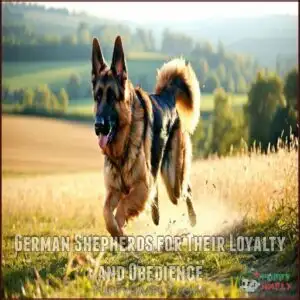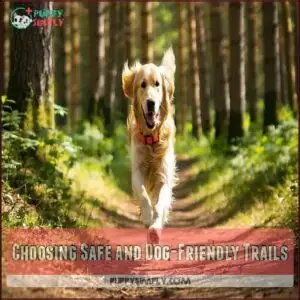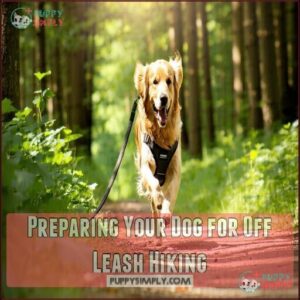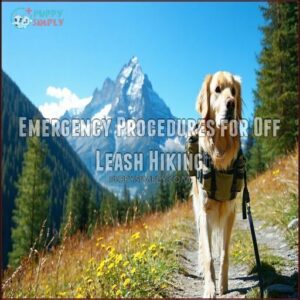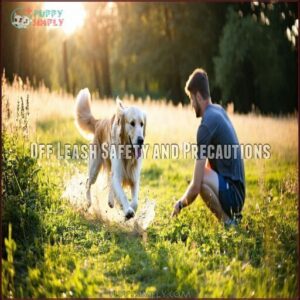This site is supported by our readers. We may earn a commission, at no cost to you, if you purchase through links.
 You’re looking for the best off-leash dogs, and some breeds are naturally more inclined to thrive without a leash.
You’re looking for the best off-leash dogs, and some breeds are naturally more inclined to thrive without a leash.
Border Collies, German Shepherds, Labrador Retrievers, and Golden Retrievers stand out for their intelligence, loyalty, and high energy levels.
These breeds are perfect for active owners who want to give their dogs freedom.
When choosing the best off-leash dogs, consider their energy levels, and you’ll want to know more about training and preparing your dog for off-leash adventures, and what breeds are best suited for your lifestyle and environment.
Table Of Contents
- Key Takeaways
- Best Off Leash Dog Breeds
- Top Characteristics for Off Leash Dogs
- Breeds With Excellent Off Leash Recall
- Factors Affecting Off Leash Success
- Essential Tips for Off Leash Hiking
- Training Your Dog for Off Leash Adventures
- Off Leash Safety and Precautions
- Best Off Leash Dog Breeds for Families
- Off Leash Dog Breeds for Specific Environments
- Finding The Right Off Leash Dog Breed for You
- Frequently Asked Questions (FAQs)
- What breed of dog is good off-leash?
- Which dog breed is least likely to run away?
- What are the best dogs for recall?
- What breed of dog is easiest to train?
- What dog breed is least likely to run away?
- Are off-leash walks good for dogs?
- Which breed of dog has the best recall?
- What dog breed does best off leash?
- How do I know if my dog will be good off leash?
- What is the best dog off leash?
- Conclusion
Key Takeaways
- You’ll want to consider breeds like Border Collies, German Shepherds, and Labrador Retrievers, which are known for their intelligence, loyalty, and high energy levels, making them perfect for active owners who want to give their dogs freedom.
- When choosing the best off-leash dog, you’ll need to think about factors like energy levels, trainability, and temperament, and find a breed that fits your lifestyle and environment.
- You’ll need to train your dog with basic obedience commands and positive reinforcement methods to help them become a reliable off-leash companion, and consider advanced techniques like distraction training and recall proofing.
- You should assess your lifestyle and needs, research different breeds and their characteristics, and consult with breeders and rescue organizations to find a breed that’s well-suited for off-leash activities and makes a great companion for you.
Best Off Leash Dog Breeds
You’re looking for the best off-leash dog breeds that can keep up with your active lifestyle.
Find your perfect off-leash companion today
By considering factors like intelligence, energy levels, and loyalty, you can find a breed that’s perfect for off-leash adventures and a great companion for you.
Intelligent Breeds for Off Leash Adventures
You’ll excel at off-leash training with intelligent breeds.
Intelligent breeds make off-leash training a breeze with their high cognitive skills and adaptability.
They’ve high Breed IQ, strong cognitive skills, and adaptability. Consider:
- Border Collies
- Poodles
- German Shepherds
Their problem-solving skills shine, making off-leash adventures easier with the right training methods.
Energetic Breeds for Active Owners
You’re looking for a dog that can keep up with your active lifestyle. Certain breeds thrive on exercise and mental stimulation.
These breeds have specific needs, as outlined below:
| Breed | Energy Levels | Exercise Requirements |
|---|---|---|
| Border Collie | High | Daily runs |
| Australian Shepherd | High | Long hikes |
| Labrador Retriever | Medium | Swimming and hiking |
These active dogs need consistent training and off-leash training to stay happy. With the right balance of exercise and care, you’ll find a lifelong companion for adventures. Consider Breed Energy Levels and training consistency for off-leash safety.
Loyal Breeds for Reliable Recall
You want loyal breeds for reliable recall.
Consider these:
- Doberman Pinschers
- Border Collies
- Labrador Retrievers
- Golden Retrievers, which thrive on bonding techniques and recall training, showcasing their breed temperament and loyalty.
Trainable Breeds for Easy Off Leash Training
You’ll find several dog breeds suitable for off-leash training, including Poodles and Labradors.
| Breed | Trainability | Energy |
|---|---|---|
| Poodle | High | Medium |
| Labrador | High | High |
| Golden | High | High |
| German Shepherd | High | High |
The table provides a summary of the breeds, highlighting their trainability and energy levels.
Top Characteristics for Off Leash Dogs
You’re looking for a dog that can thrive off-leash, and it’s vital to think about the top characteristics that make a dog suitable for this type of activity.
You’ll want a dog with high intelligence, a strong bond with you, and a good temperament to guarantee safe and enjoyable off-leash experiences, particularly one with a strong bond.
High Intelligence for Easy Training
Smart dogs make off-leash training easier. Breed Intelligence helps a lot. With dog breeds like Border Collies or Poodles dog training is straightforward.
These dogs thrive on mental stimulation. They learn commands quickly through repetition. Their sharp command retention and problem-solving skills make adapting to new routines easy.
- Breed trainability guarantees progress.
- Learning speed enhances focus.
- Command recognition boosts reliability.
- Adaptability helps dogs succeed.
Strong Bond With Owners for Reliable Recall
You build a strong bond with your dog through positive reinforcement and consistent training.
This emotional connection enhances recall reliability, obedience, and loyalty.
Breed temperament and training consistency play a role in off-leash training.
By investing time in bonding activities, you establish owner trust, essential for reliable recall and dog obedience training, especially in off-leash situations where consistent training is crucial.
High Energy Levels for Active Owners
You need a dog that matches your active lifestyle.
Consider breeds with high energy levels, such as:
- Border Collies
- Australian Shepherds
- Vizslas
- Labrador Retrievers, requiring consistent training and exercise to prevent boredom, ensuring best off-leash experiences.
Good Temperament for Safe Interactions
You want a dog with a good temperament for safe interactions.
Calm breeds with low fearfulness and high aggression thresholds excel.
Child-Friendly Breeds require strong dog socialization skills, avoiding fearful temperaments and aggression triggers, ensuring a trust-filled outing with your dog, considering breed stereotypes and dog temperament.
Breeds With Excellent Off Leash Recall
You’re looking for breeds that excel in off-leash recall, and there are several that stand out for their intelligence, loyalty, and trainability.
Breeds like Border Collies, German Shepherds, and Labrador Retrievers are known for their excellent recall, making them great companions for off-leash adventures.
Border Collies for Their Intelligence and Trainability
You’re looking for a breed that excels in off-leash training, and Border Collies are a great choice.
They possess high dog intelligence and breed specificity, making them highly trainable. To manage training challenges, consider their herding instincts and energy management needs.
- Tap into their mental stimulation
- Use positive reinforcement
- Provide creative exercises
- Build a strong bond
- Offer regular breaks
- Celebrate their quick learning, making off-leash training a breeze for this intelligent dog breed, with high dog intelligence.
German Shepherds for Their Loyalty and Obedience
You’ll love German Shepherds for their loyalty and obedience.
With proper training methods, this breed excels at recall, offering freedom and security outdoors.
This is thanks to their GSD temperament and breed history as working dogs.
Labrador Retrievers for Their Friendly and Outgoing Nature
After exploring German Shepherds, consider Labrador Retrievers. Their friendly and outgoing nature makes them fantastic off-leash partners.
Labs’ retrieving instincts and Labrador Temperament shine. Their Retriever Trainability guarantees quick mastery of commands. You’ll appreciate their focus.
- Labs’ energy suits active owners
- Off leash training is easier
- Labs maintain focus
- Labrador Retriever temperament fosters family bonds
Labs are great dog breeds for families. Enjoy your off leash adventures.
Golden Retrievers for Their Intelligence and Loyalty
Beyond Labrador Retrievers, Golden Retrievers shine with intelligence and loyalty. You’ll find off leash training easy. Their dog breed intelligence means quick learning. Dog loyalty means they check in.
Here’s why they’re great off-leash:
- Golden Temperament: Calm and enthusiastic
- Family Suitability: Gentle with kids
- Training Techniques: Masters commands
- Exercise Needs: Stays active
Their popularity speaks volumes. Trust this companion outdoors. Consider health concerns. Golden Retriever is a top choice for dog breeds for families, known for their loyalty.
Factors Affecting Off Leash Success
You’re considering taking your dog off-leash, but you’re not sure what factors will affect its success.
You’ll need to evaluate your dog’s age, energy levels, and confidence, as well as climate and temperature, to guarantee a safe and enjoyable experience.
Dog Age and Maturity for Off Leash Training
You face unique challenges with off-leash training based on your dog’s age.
Puppy immaturity and adolescent distractions require patience.
Adult reliability often comes after consistent recall training.
Create a training timeline to guarantee off-leash success, addressing adolescent challenges and senior limitations for effective dog training and socialization.
Climate and Temperature Regulation for Safe Off Leash Activities
When hiking with your dog, consider weather conditions.
Use Heatstroke Prevention strategies and Cold Weather Gear.
Prioritize Hydration Strategies and Breed Sensitivity to guarantee dog weather safety.
Pack water and choose cooler times to protect your dog from extreme temperatures and potential heatstroke during off-leash hikes outdoors.
A Dog’s Energy Levels and Exercise Needs
Your dog’s energy levels play a significant role in off-leash enjoyment.
High-energy breeds like Border Collies thrive on intense activities, while moderate breeds like Labradors enjoy swimming or fetch.
Match their energy to the activity, and consider off-leash parks for burning energy.
Consistent exercise prevents boredom and supports weight management.
Tailor activities to your dog’s breed energy levels, including exercise frequency and mental stimulation, to guarantee they’re happy and engaged, making them perfect dog breeds for active owners with suitable dog exercise and dog energy needs.
A Dog’s Confidence and Trust in Owners
How do you build a confident off-leash dog? Start by fostering trust through consistent actions and positive reinforcement. This secure attachment is key. A strong dogowner bond builds mutual respect and clear communication.
It also improves offleash training. Positive reinforcement relies on rewarding desired behaviors.
The benefits of this approach include:
- Fewer surprise vet visits.
- Happy tail wags.
- Peaceful coexistence.
Building confidence enhances behavior. This matters for dog breeds for active owners and dog breeds for companionship.
Essential Tips for Off Leash Hiking
You’re getting ready to take your dog on an off-leash hike, and this is vital to prepare yourself and your pet.
You’ll need to choose safe trails, prepare your dog with proper training, and pack the right gear to guarantee a fun and safe experience for both of you.
Choosing Safe and Dog-Friendly Trails
When planning off-leash adventures, consider Trail Accessibility and Terrain Difficulty. Verify that water sources are available and Wildlife Presence is minimal.
Check local Leash Laws and opt for dog-friendly parks.
Prioritize dog hiking safety by evaluating your off-leash dog’s fitness level and choosing suitable hiking trails. This helps create a pleasant experience for both you and your dog, while respecting the environment and other trail users, and ensuring dog safety on off-leash outings.
Preparing Your Dog for Off Leash Hiking
With trail selection settled, let’s prep your pal for offleash safety.
- Solidify recall training for recall reliability.
- Acclimate to gear to boost dog hiking safety.
- Refine dog socialization skills.
- Replicate conditions to sharpen wildlife awareness.
Master recall training for offleash safety. Use harnesses for outdoor dog activities. Consider using an off leash alternative for added control.
Dog behavior modification through socialization aids confidence. Mimic trail conditions to boost fitness.
Preparation guarantees fun stronger bonds and emergency preparedness. Don’t forget hydration needs.
Pet Essentials for a Safe and Enjoyable Hike
For a safe hike, you’ll need hydration solutions, paw protection, and a first-aid kit.
Pack essentials like tick prevention and trail nutrition.
Consider a portable bowl and backup leashes for offleash dogs.
Endurance breeds like Siberian Huskies make great companions on long treks.
Prioritize dog emergency preparedness and bring a dog first aid kit to guarantee a fun, safe adventure with your dog breeds for hiking.
Emergency Procedures for Off Leash Hiking
Your off-leash hiking adventures require preparation. Pack a dog first aid kit and learn injury response.
- Carry a whistle
- Know emergency contacts
- Stay vigilant for hazards, considering wildlife encounters and weather extremes for safe emergency preparedness.
Training Your Dog for Off Leash Adventures
You’re taking the first step to train your dog for off-leash adventures, which requires patience and practice.
By following basic obedience commands and using positive reinforcement methods, you can help your dog become a reliable off-leash companion.
Basic Obedience Commands for Off Leash Training
Once you’ve packed your bag, it’s time for dog obedience. Off-leash freedom starts with basic commands. You’ll need "sit-stay" and "leave it." Also, practice heel training. These build trust. They also improve your dog’s response.
- A wagging tail on a boundless trail.
- The thrill of a successful Recall Command.
- Unbreakable trust between you and your dog.
Use positive reinforcement training. Reward your dog when they come back. You’ll also want to master the Stay Command. Practice Heel Training often. Consistency is key for success! Using motivational training incentives can greatly improve results.
Advanced Training Techniques for Reliable Recall
You’re building on basic obedience commands.
Now, master recall with advanced techniques like Distraction Training and Recall Proofing.
Use tools like E-Collar Training for precision.
Consistent training can establish a reliable recall in various environments.
Sessions should be fun, yet structured, to strengthen your dog’s focus and responsiveness, enhancing dog obedience and recall training for a stronger bond.
Positive Reinforcement Methods for Off Leash Training
After mastering advanced recall training for dogs, let’s explore positive reinforcement. Boost your dog’s off-leash reliability with treat rewards and clicker training. You can also use toy motivation.
Combine recall games with verbal praise. Shaping behavior becomes easier.
- Consistent obedience training
- Dog breed trainability
- Positive reinforcement
- Playfulness and patience
- Trust and confidence
These dog training methods strengthen your bond.
Avoiding Common Mistakes in Off Leash Training
When training off-leash,
- practice recall reliably
- avoid rushing training
- use consistent commands to prevent confusion and ignoring instincts, ensuring successful recall training for dogs and addressing potential dog behavior problems.
Off Leash Safety and Precautions
You’re taking your dog off-leash, and it’s vital to think about safety precautions to guarantee a fun and safe experience for both you and your pet.
You’ll want to be aware of potential hazards, prepare for emergency situations, and take steps to guarantee your dog’s safety and well-being.
Potential Hazards and Risks of Off Leash Activities
When venturing with offleash dogs, consider wildlife encounters, terrain hazards, and lost dogs.
Safety considerations are vital, including legal liabilities and weather risks, to guarantee a fun experience with your dog, prioritizing precautions and awareness to minimize potential dangers and risks associated with offleash activities and dog wildlife encounters.
Preparing for Emergency Situations
You’ll need an off-leash dog safety kit with:
- Emergency First-Aid
- Lost Dog Protocol
- Injury Prevention tips to facilitate dog recall and self-preservation, considering dog breed safety considerations and emergency preparedness for wildlife encounters and weather extremes.
You may need off leash first-aid products in your kit, which should include complete concepts such as Emergency First-Aid and Injury Prevention to ensure off-leash safety.
Ensuring Your Dog’s Safety and Well-being
You prioritize your dog’s well-being with routine vet visits and balanced nutrition.
Guarantee their safety with emergency kits, proper hydration, and mental stimulation.
Consider breed health and self-preservation instincts when choosing off-leash gear, promoting socialization and responsible behavior management to keep them safe and happy.
Respecting Other Trail Users and Wildlife
After guaranteeing your dog’s safety, remember trail etiquette. It guarantees harmony. Respect other trail users and protect wildlife. Offleash dogs require responsible handling.
Keep your dog under control. Use reliable recall. It prevents disturbances. Follow leash laws. Practice noise control. Avoid startling wildlife. Proper waste disposal is key.
Many struggle with dog behavior like leash pulling. Consider your dog breed offleash suitability and dog socialization. Make certain their dog breed selfpreservation instincts are sharp.
- Yield to other trail users.
- Redirect your dog from chasing wildlife.
- Stick to designated trails. This ensures harmony and prevents disturbances, allowing for responsible handling and proper waste disposal.
Best Off Leash Dog Breeds for Families
You’re looking for the best off-leash dog breeds for your family, and this is vital: factors like energy levels, trainability, and temperament.
By choosing a breed that fits your lifestyle, you can guarantee a safe and enjoyable off-leash experience for both you and your dog.
Breeds Suitable for Families With Small Children
You’re looking for a dog breed suitable for families with small children. Consider breeds with Child-Safe Temperaments.
- Labrador Retrievers
- Golden Retrievers
- Beagles
- Cavalier King Charles Spaniels
They offer an Energy Level Match and have a suitable Breed Size. Remember, Training Needs and Supervision Importance are key to a harmonious family environment.
Golden Retrievers excel in versatility and adaptability, making them a great choice. Choose a breed with a gentle nature to guarantee dog breed suitability for families and children.
Breeds Suitable for Families With Active Lifestyles
You’ll thrive with Border Collies, Australian Shepherds, and Labrador Retrievers, stellar off-leash dogs.
These family-friendly breeds love outdoor adventures, pairing well with active lifestyles, and require regular exercise and mental stimulation, making them perfect companions for adventures with proper training and temperament traits.
Consider that many breeds require high-intensity exercise to thrive.
Breeds Suitable for Families With Limited Space
You can enjoy family dogs despite limited space.
Consider small dog breeds like
- Miniature Poodles
- Miniature Schnauzers
- French Bulldogs, which are Low-Energy Companions with Minimal Exercise Needs, perfect for Apartment-Friendly Training and Quiet Breed Options.
Breeds Suitable for Families With Allergy Concerns
For families with allergy concerns, consider hypoallergenic breeds like Poodles, with low-shedding coats minimizing dander.
Regular grooming reduces dander, keeping them off-leash ready.
Poodles and Bichon Frises are ideal, offering high dander reduction and family compatibility, making them great dog breeds for children and suitable family pets with low-shedding coats.
Off Leash Dog Breeds for Specific Environments
You’re looking for dog breeds that thrive in specific environments, and you want to know which ones are best suited for different climates and settings.
You’ll find breeds that excel in hot and humid climates, cold and snowy climates, urban environments, and rural environments, helping you choose the perfect off-leash dog for your lifestyle.
Breeds Suitable for Hot and Humid Climates
Thinking about off-leash fun in hot weather? Some dog breeds for outdoors handle the heat better. Their dog breed weather tolerance is impressive.
Here are a few heat-loving pals:
- Australian Shepherd: These energetic dogs thrive even when it’s hot and humid.
- Vizsla: Thanks to their breed origins they can adapt well.
- Dalmatian: These dogs can handle various environments.
- Boxer: They can adapt to hot and humid climates.
Consider dog breed coat characteristics. Coat type matters. Hydration needs are essential. Exercise timing should be during cooler hours. Heatstroke prevention is key. Keep their dog breed energy levels in mind.
Breeds Suitable for Cold and Snowy Climates
You’re looking for dog breeds that excel in cold and snowy climates.
Consider coat thickness and cold tolerance.
| Breed Origins | Winter Exercise |
|---|---|
| Siberian Husky | High |
| Alaskan Malamute | High |
| Samoyed | Medium |
They need paw protection for snowy trails, making them best dog breeds for outdoors with high dog breed weather tolerance.
Breeds Suitable for Urban Environments
You’ll find several Apartment-Friendly Breeds thrive in urban environments, including:
- Poodles
- Boston Terriers
- Cavalier King Charles Spaniels
- French Bulldogs
- Basenjis
which require socialization and Exercise in Cities, coping with Noise Level Concerns and Urban Hazards, particularly Noise Level Concerns.
Breeds Suitable for Rural Environments
A rural environment is where some dog breeds truly thrive. They’ve got the energy and can handle the open space exercise.
Here are four standout farm dog breeds:
- Border Collie: Smart and ready for countryside dog training.
- Brittany: Known for dog breed hunting instincts.
- Australian Shepherd: Exceptional dog breeds for herding.
- Vizsla: Adapts to rural breed temperament.
Finding The Right Off Leash Dog Breed for You
You’re looking for a dog breed that’s perfect for off-leash adventures, and it’s important to find one that fits your lifestyle.
By evaluating your needs and finding different breeds, you can find a breed that’s well-suited for off-leash activities and makes a great companion.
Assessing Your Lifestyle and Needs
Evaluate your activity level, living situation, and family dynamic to determine the best dog breed for you.
Consider your time commitment and research breeds that fit your lifestyle, ensuring a suitable match for a happy and healthy relationship with your dog.
Researching Different Breeds and Their Characteristics
Now that you’re clear on your needs, let’s explore dog breed characteristics! Researching offleash dog breeds means checking temperaments, energy, and grooming.
- Breed Temperaments: Calm herding breeds bond deeply.
- Breed Energy: High-energy dogs thrive outdoors.
- Breed Intelligence: Smarts help recall.
Consider breed history and health. Match a dog breed’s athleticism and training needs to your lifestyle for offleash reliability!
Consulting With Breeders and Rescue Organizations
You’re one step closer to finding your perfect off-leash dog.
Consulting breeders and rescues helps match a breed’s temperament and energy with your lifestyle.
Breeders offer health guarantees, while rescues provide temperament assessment.
Research breeder reputation and rescue transparency to guarantee responsible dog ownership.
Consider breed suitability and dog breed recommendations for a harmonious match, prioritizing health guarantees and temperament assessment for informed dog breed selection and rescue.
Frequently Asked Questions (FAQs)
What breed of dog is good off-leash?
You’ll find breeds like Border Collies, German Shepherds, and Australian Shepherds excel off-leash due to their intelligence, obedience, and strong bond with owners.
Which dog breed is least likely to run away?
You’ll likely find Vizslas are least likely to run away, as they’re known for forming strong bonds and staying close to their owners, earning them the "Velcro dog" nickname.
What are the best dogs for recall?
You’ll find breeds like Border Collies, German Shepherds, and Australian Shepherds excel at recall due to their high intelligence, obedience, and strong bond with owners.
What breed of dog is easiest to train?
You’ll find breeds like Border Collies and Poodles are often easiest to train due to their high intelligence and willingness to please their owners with consistent practice.
What dog breed is least likely to run away?
You’ll find breeds like Vizsla, with strong bonding instincts, are less likely to run away, making them a great choice for owners seeking a loyal companion.
Are off-leash walks good for dogs?
Off-leash walks can be great.
They let your dog explore and burn energy.
You’ll need good recall training first.
Socialization and knowing your dog’s breed help too.
Always consider safety and local rules.
Which breed of dog has the best recall?
You’ll find the Border Collie often has the best recall.
They’re super smart and obedient.
With proper training and a strong bond you can trust they’ll come back when you call them.
What dog breed does best off leash?
You’ll do best with breeds like Border Collies, German Shepherds, or Australian Shepherds, which are highly intelligent, obedient, and responsive to training, making them ideal off-leash companions.
How do I know if my dog will be good off leash?
What’s holding you back? You’ll know if your dog is good off-leash by evaluating their intelligence, obedience, and energy levels, considering breed traits and training effectiveness too.
What is the best dog off leash?
You’ll find suitable breeds like Border Collies, German Shepherds, and Australian Shepherds, known for intelligence, obedience, and strong bonds with owners, making them reliable off-leash companions with proper training.
Conclusion
You’ll find the perfect companion with the best off leash dogs, as 75% of owners prefer breeds like Border Collies.
Consider your lifestyle and choose a breed that suits you.
With proper training, you’ll enjoy off-leash adventures with your dog, making the best off leash dogs a great fit for active owners who prefer off-leash adventures.




